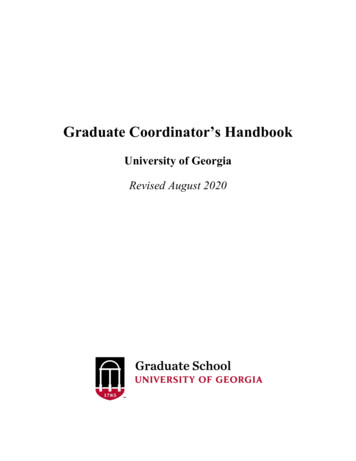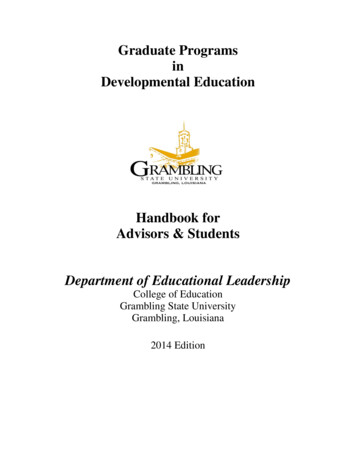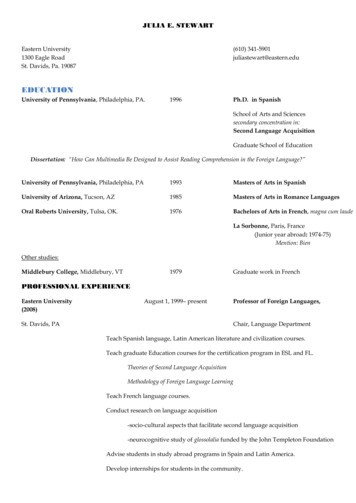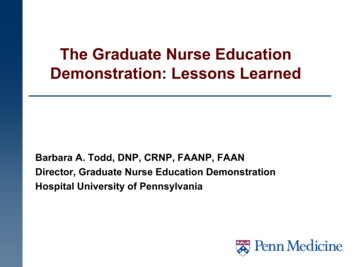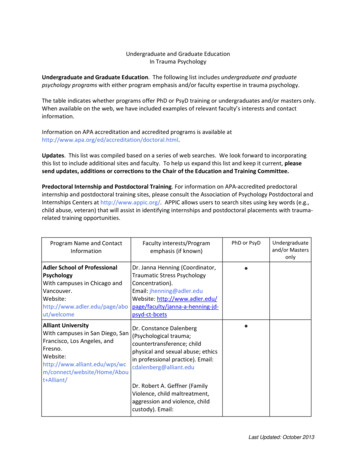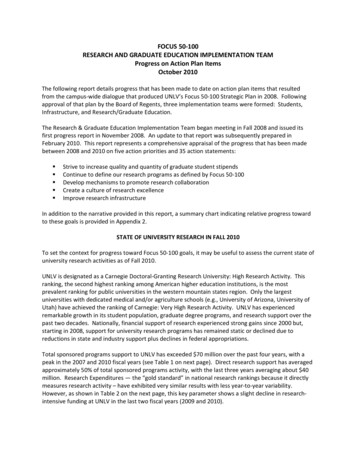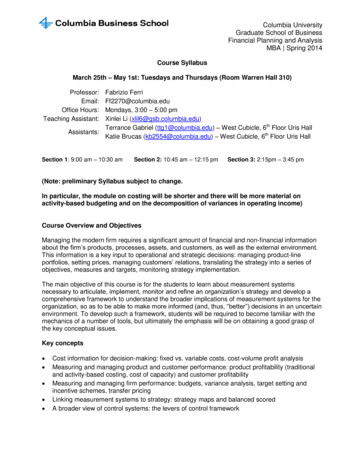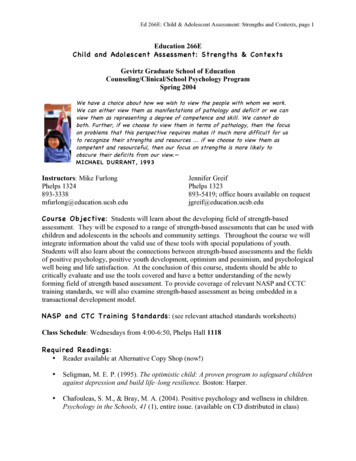
Transcription
Ed 266E: Child & Adolescent Assessment: Strengths and Contexts, page 1Education 266EChild and Adolescent Assessment: Strengths & ContextsGevirtz Graduate School of EducationCounseling/Clinical/School Psychology ProgramSpring 2004We have a choice about how we wish to view the people with whom we work.We can either view them as manifestations of pathology and deficit or we canview them as representing a degree of competence and skill. We cannot doboth. Further, if we choose to view them in terms of pathology, then the focuson problems that this perspective requires makes it much more difficult for usto recognize their strengths and resources . if we choose to view them ascompetent and resourceful, then our focus on strengths is more likely toobscure their deficits from our view.—MI CHA EL D URR ANT , 199 3Instructors: Mike FurlongPhelps 1324893-3338mfurlong@education.ucsb.eduJennifer GreifPhelps 1323893-5419; office hours available on requestjgreif@education.ucsb.eduCourse Objective: Students will learn about the developing field of strength-basedassessment. They will be exposed to a range of strength-based assessments that can be used withchildren and adolescents in the schools and community settings. Throughout the course we willintegrate information about the valid use of these tools with special populations of youth.Students will also learn about the connections between strength-based assessments and the fieldsof positive psychology, positive youth development, optimism and pessimism, and psychologicalwell being and life satisfaction. At the conclusion of this course, students should be able tocritically evaluate and use the tools covered and have a better understanding of the newlyforming field of strength based assessment. To provide coverage of relevant NASP and CCTCtraining standards, we will also examine strength-based assessment as being embedded in atransactional development model.NASP and CTC Training Standards: (see relevant attached standards worksheets)Class Schedule: Wednesdays from 4:00-6:50, Phelps Hall 1118Required Readings: Reader available at Alternative Copy Shop (now!) Seligman, M. E. P. (1995). The optimistic child: A proven program to safeguard childrenagainst depression and build life–long resilience. Boston: Harper. Chafouleas, S. M., & Bray, M. A. (2004). Positive psychology and wellness in children.Psychology in the Schools, 41 (1), entire issue. (available on CD distributed in class)
Ed 266E: Child & Adolescent Assessment: Strengths and Contexts, page 2 [Supplemental] Huebner, E. Scott, & Gilman, R. (Eds.). (2003). Toward a focus onpositive psychology in school psychology. School Psychology Quarterly, 18 (2), entireissue. (checking on electronic and back ordering)Over view of Course Assignments:1. Class participation and completion of weekly readings. Attendanceand participation at each class, and completion of all readings and reviews is essential togain the full benefits of this class.2. Reading reactions. For each week’s reading, identify an idea or a few sentencesfrom the reading that you have highlighted. In a Word document, type up this sectionfrom the reading and briefly explain why you selected that statement (e.g., it wasespecially interesting, controversial, challenged your beliefs). Bring a note card to classeach week with the statement. At the end of the quarter you will be asked to turn in theWord document with all of your selections and justifications.3. Paper Article reviews. Complete a 1-page written review and class presentationof two (2) articles reviewed for you class paper. Please have copies of these reviewsavailable to your classmates. Have all files in Word or PDF format so that we can beginto build a web resource of strength-based materials. This will start in week 4. A sign-upsheet will be distributed during the first class meeting.4. Paper. Complete a 10-page paper (including references) on a topic relevant tostrength–based assessments. Turn in a brief (few sentences) explanation of your papertopic in week 3. Provide a reference list on week 8 (plan to include about 10 references)Some suggestions for paper topics: Choose one of the “constructs” of strength-based assessment (e.g., Hardiness, Humor,Persistence, Optimism, Happiness, Life Satisfaction, Social Support, Flow). Reviewthe construct, how it relates to strength-based assessments, show how it has been usedin research, and discusses your ideas about how it might be included in school-basedand other assessments. Emotional Intelligence: Describe what it is and what programs are designed toenhance Emotional Intelligence (e.g., the work of Ellias or Gardner). School-Based Social Skills Development: Describe how you would use theinformation in this class to develop programs that increase strengths (rather thanfocusing on therapeutic techniques that address deficits) Discuss how strengths/ positive psychology is used in a therapeutic context to drivetheory, case conceptualization, and intervention techniques (e.g., solution-focusedcounseling, the miracle cure).
Ed 266E: Child & Adolescent Assessment: Strengths and Contexts, page 3 Physical Health: What are schools doing to promote physical wellness? How doesthis relate to the rise of obesity in the country? What strengths are associated withphysical wellness? How is immune system response impacted by the topics we havediscussed in class? Memories: How are memories used to preserve positive ideas about the past? Whydo some people have memories of good times, while other people focus on negativeevents? How are the strengths discussed in class related to the formation of positivememories? Examine the concept of the golden proportion hypotheses or what is called States ofMind Ratio research. Focus specifically on assessment and related issues pertaining tochildren and adolescents.(for example: TITLE: Convergent validity in cognitive assessment of social anxiety:Endorsement versus production methods in deriving states of mind ratio.ABSTRACT : Evaluated the convergent validity of 2 methods of assessing cognitiveself-statements relative to social anxiety: an endorsement method (the SocialInteraction Self-Statement Test, SISST; C. R. Glass et al, 1982) and a productionmethod (thought-listing; J. T. Cacioppo et al, 1979). 133 undergraduate Ss (mean age19.6 yrs) were randomly assigned to either method and exposed to a get-acquaintedconversation after which they completed 1 of 2 self-statement measures (SISST orthought-listing). After converting self-statement scores to a states of mind (SOM)ratio, results showed the SISST yielded a significantly more adaptive SOM (.70) thanthe thought-listing SOM (.47). Also, the SISST was superior to thought-listing inaccounting for predicted variance in 3 of 4 criterion measures. Reasons for lack ofconvergent validity and implications for future research are discussed. (PsycINFODatabase Record (c) 2003 APA, all rights reserved). AUTHOR: Sturmer, Paul J.;Bruch, Monroe A.; Haase, Richard F.; Amico, K. Rivet Take a stand vis-à-vis the quote on page 1. Is this true? Does this over play thedistinction between strength-based and pathology-based assessment? Are they trulymutually exclusive? What approaches have others, would you, suggest whenexploring the needs of children and adolescents? Other topics can be selected in consultation with the instructor.During week 10 you will present your paper to the class, using a brief PowerPointpresentation (about 5-10 slides).The paper must carefully follow APA-style formatting. Here are some web sites thatprovide APA format htmhttp://www.kelcom.igs.net/ nhodgins/apa format uides/apacitation.pdf
Ed 266E: Child & Adolescent Assessment: Strengths and Contexts, page -3031395-0967026 (to buythe 4th edition of the APA Style /dept/psych/apastyle.htmlIf you locate other sites, please share them with the class.****Note: For all class assignments that ask you to submit an electronic file, please use a filename that identifies you as the author.Strength–Based Assessment Readings and Assignments(March 31)Optimistic Child pages 1-112.(April 7)Optimistic Child pages 115-299.Jimerson, S. R., Sharkey, J. D., Nyborg, V., & Furlong, M. J. (in press) Strength-BasedAssessment and School Psychology: A Summary and Synthesis. California SchoolPsychologist.Epstein, M. H., Rudolph, S., & Epstein, A. A. (2000). Strength-based assessment. TeachingExceptional Children, 32(6), 50-54.(April 14)Proposal for Paper Topic DueLarson, R. W. (2000). Toward a psychology of positive youth development. AmericanPsychologist, 55(1), 170-183.CD—Clonan et al.CD—Gilman et al.(April 21)Epstein, M. H., Harniss, M. K., Robbins, V., Wheeler, L., Cyrulik, S., Kriz, M., & Nelson, J. R.(in press). Strength-based approaches to assessment in schools. In M. Weist, S. Evans,& N. Tashman (Eds.). School Mental Health Handbook. New York: KluwerAcademic/Plenum Publishers.CD—Terjesen et al.CD—Akin-Little et al.
Ed 266E: Child & Adolescent Assessment: Strengths and Contexts, page 5(April 28)Schneider, S. L. (2001). In search of realistic optimism: Meaning, knowledge, and warmfuzziness. American Psychologist, 56(3), 250-263Boman, P., & Yates, G. C. (2001). Optimism, hostility, and adjustment in the first year of highschool. British Journal of Educational Psychology, 71, 401-411.CD—Jensen et al.(May 5)Ryan, R. M., & Deci, E. L. (2000). Self-determination theory and the facilitation of intrinsicmotivation, social development and well-being. American Psychologist, 55(1), 68-78.CD—Martens et al.CD—McLoughlin et al.(May 12)Saunders, R., & Pate, R. (2001). Promoting physical health. In K. M. Minke & G. C. Bear(Eds.), Preventing School Problems – Promoting School Success (pp. 337-374),Washington, D.C.: National Association of School Psychologists.CD—Kehele & BrayCD—Huebner et al.(May 19)Annotated Bibliography for Paper DueLarson, R. W., & Richards, M. H. (1991). Boredom in the middle school years: Blamingschools versus blaming students. American Journal of Education, 99, 418-443.Larson, R. W., & Verma, S. (1999). How children and adolescents spend time across the world:Work, play and developmental opportunities. Psychological Bulletin, 125, 701-736.(May 26)Positive Youth Development and Student SuccessSchool Engagement(June 2 – Finals Week)Paper Presentations and DiscussionJune 7 Final Paper DueInternet Strengths and Assets Web ength/sba.htmhttp://cecp.air.org/discstrength post.htm
Ed 266E: Child & Adolescent Assessment: Strengths and Contexts, page gies/TS 2001 sanjuan.edu/osapp/building bridges/building php?b 0&p a.us/youth support .htm
Counseling/Clinical/School Psychology Program Spring 2004 We have a choice about how we wish to view the people with whom we work. We can either view them as manifestations of pathology and deficit or we can view them as represen
